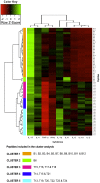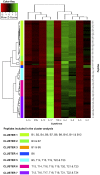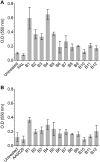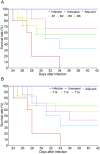In vitro and in vivo studies for assessing the immune response and protection-inducing ability conferred by Fasciola hepatica-derived synthetic peptides containing B- and T-cell epitopes
- PMID: 25122166
- PMCID: PMC4133369
- DOI: 10.1371/journal.pone.0105323
In vitro and in vivo studies for assessing the immune response and protection-inducing ability conferred by Fasciola hepatica-derived synthetic peptides containing B- and T-cell epitopes
Abstract
Fasciolosis is considered the most widespread trematode disease affecting grazing animals around the world; it is currently recognised by the World Health Organisation as an emergent human pathogen. Triclabendazole is still the most effective drug against this disease; however, resistant strains have appeared and developing an effective vaccine against this disease has increasingly become a priority. Several bioinformatics tools were here used for predicting B- and T-cell epitopes according to the available data for Fasciola hepatica protein amino acid sequences. BALB/c mice were immunised with the synthetic peptides by using the ADAD vaccination system and several immune response parameters were measured (antibody titres, cytokine levels, T-cell populations) to evaluate their ability to elicit an immune response. Based on the immunogenicity results so obtained, seven peptides were selected to assess their protection-inducing ability against experimental infection with F. hepatica metacercariae. Twenty-four B- or T-epitope-containing peptides were predicted and chemically synthesised. Immunisation of mice with peptides so-called B1, B2, B5, B6, T14, T15 and T16 induced high levels of total IgG, IgG1 and IgG2a (p<0.05) and a mixed Th1/Th2/Th17/Treg immune response, according to IFN-γ, IL-4, IL-17 and IL-10 levels, accompanied by increased CD62L+ T-cell populations. A high level of protection was obtained in mice vaccinated with peptides B2, B5, B6 and T15 formulated in the ADAD vaccination system with the AA0029 immunomodulator. The bioinformatics approach used in the present study led to the identification of seven peptides as vaccine candidates against the infection caused by Fasciola hepatica (a liver-fluke trematode). However, vaccine efficacy must be evaluated in other host species, including those having veterinary importance.
Conflict of interest statement
Figures











Similar articles
-
Transcriptome profiling of gene expression during immunisation trial against Fasciola hepatica: identification of genes and pathways involved in conferring immunoprotection in a murine model.BMC Infect Dis. 2017 Jan 23;17(1):94. doi: 10.1186/s12879-017-2205-3. BMC Infect Dis. 2017. PMID: 28114888 Free PMC article.
-
Identification of Fasciola hepatica recombinant 15-kDa fatty acid-binding protein T-cell epitopes that protect against experimental fascioliasis in rabbits and mice.J Parasitol. 2007 Aug;93(4):817-23. doi: 10.1645/GE-1050R1.1. J Parasitol. 2007. PMID: 17918360
-
Antibody recognition of cathepsin L1-derived peptides in Fasciola hepatica-infected and/or vaccinated cattle and identification of protective linear B-cell epitopes.Vaccine. 2018 Feb 8;36(7):958-968. doi: 10.1016/j.vaccine.2018.01.020. Epub 2018 Jan 17. Vaccine. 2018. PMID: 29373193
-
Protective efficacy of liver fluke DNA vaccines: A systematic review and meta-analysis: Guiding novel vaccine development.Vet Parasitol. 2019 Mar;267:90-98. doi: 10.1016/j.vetpar.2019.01.010. Epub 2019 Feb 16. Vet Parasitol. 2019. PMID: 30878093
-
Immunomodulatory molecules of Fasciola hepatica: candidates for both vaccine and immunotherapeutic development.Vet Parasitol. 2013 Aug 1;195(3-4):272-85. doi: 10.1016/j.vetpar.2013.04.008. Epub 2013 Apr 6. Vet Parasitol. 2013. PMID: 23623183 Review.
Cited by
-
Evaluation of a Commercial Enzyme-Linked Immunosorbent Assay Kit and In-House Fasciola gigantica Cysteine Proteinases-Based Enzyme-Linked Immunosorbent Assays for Diagnosis of Human Fascioliasis.Am J Trop Med Hyg. 2019 Mar;100(3):591-598. doi: 10.4269/ajtmh.18-0833. Am J Trop Med Hyg. 2019. PMID: 30675852 Free PMC article.
-
Transcriptomic Study on Ovine Immune Responses to Fasciola hepatica Infection.PLoS Negl Trop Dis. 2016 Sep 23;10(9):e0005015. doi: 10.1371/journal.pntd.0005015. eCollection 2016 Sep. PLoS Negl Trop Dis. 2016. PMID: 27661612 Free PMC article.
-
Peptides Derived of Kunitz-Type Serine Protease Inhibitor as Potential Vaccine Against Experimental Schistosomiasis.Front Immunol. 2019 Nov 1;10:2498. doi: 10.3389/fimmu.2019.02498. eCollection 2019. Front Immunol. 2019. PMID: 31736947 Free PMC article.
-
Fasciola gigantica vaccine construct: an in silico approach towards identification and design of a multi-epitope subunit vaccine using calcium binding EF-hand proteins.BMC Immunol. 2023 Jan 5;24(1):1. doi: 10.1186/s12865-022-00535-y. BMC Immunol. 2023. PMID: 36604615 Free PMC article.
-
A Brief Review of Computer-Assisted Approaches to Rational Design of Peptide Vaccines.Int J Mol Sci. 2016 May 4;17(5):666. doi: 10.3390/ijms17050666. Int J Mol Sci. 2016. PMID: 27153063 Free PMC article. Review.
References
-
- Kaplan RM (2001) Fasciola hepatica: a review of the economic impact in cattle and considerations for control. Vet Ther 2: 40–50. - PubMed
-
- Mas-Coma S (2005) Epidemiology of fascioliasis in human endemic areas. J Helminthol 79: 207–216. - PubMed
-
- Mas-Coma S, Valero MA, Bargues MD (2009) Climate change effects on trematodiases, with emphasis on zoonotic fascioliasis and schistosomiasis. Vet Parasitol 163: 264–280. - PubMed
-
- WHO (2011) Initiative to estimate the Global burden of Foodborne Diseases. - PubMed
-
- McManus DP, Dalton JP (2006) Vaccines against the zoonotic trematodes Schistosoma japonicum, Fasciola hepatica and Fasciola gigantica. Parasitology 133 Suppl: S43–61. - PubMed
Publication types
MeSH terms
Substances
LinkOut - more resources
Full Text Sources
Other Literature Sources
Molecular Biology Databases
Research Materials

